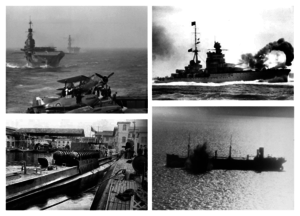Battle of the Mediterranean
World War II naval campaign in the Mediterranean Sea / From Wikipedia, the free encyclopedia
Dear Wikiwand AI, let's keep it short by simply answering these key questions:
Can you list the top facts and stats about Battle of the Mediterranean?
Summarize this article for a 10 years old
The Battle of the Mediterranean was the name given to the naval campaign fought in the Mediterranean Sea during World War II, from 10 June 1940 to 2 May 1945.
| Battle of Mediterranean | |||||||
|---|---|---|---|---|---|---|---|
| Part of the Mediterranean and Middle East theatre of World War II | |||||||
 From top left to clockwise: British aircraft carrier during the Operation Pedestal, the Italian Zara cruiser opens fire during the Battle of Cape Spartivento, an Italian merchant ship under enemy air attack, the Italian 'Gondar' submarine with the SLC cylinders on the deck. | |||||||
| |||||||
| Belligerents | |||||||
|
|
| ||||||
| Commanders and leaders | |||||||
|
|
| ||||||
| Casualties and losses | |||||||
|
Up to September 1943: Total: 76 warships of 315,500 tons 48 submarines |
Up to September 1943: 83 warships totaling 195,100 tons 84 submarines 2,018,616 tons of merchant shipping[1] c. 21,000 Royal Italian Navy personnel and c. 6,500 Italian Merchant Navy personnel killed at sea[2][3] 17 warships 68 submarines 11 warships of ~72,000 tons 7 submarines[4] | ||||||
1940
1941
1942
1943
1944 1945 | |
¹ — Involved an Allied convoy or delivery mission ² — Involved an Axis convoy or delivery mission |
For the most part, the campaign was fought between the Italian Royal Navy (Regia Marina), supported by other Axis naval and air forces, those of Nazi Germany and Vichy France, and the British Royal Navy, supported by other Allied naval forces, such as those of Australia, the Netherlands, Poland, and Greece.
American naval and air units joined the Allied side on 8 November 1942. The Vichy French scuttled the bulk of their fleet on 27 November 1942, to prevent the Germans seizing it. As part of the Armistice of Cassibile in September 1943, most of the Italian Navy became the Italian Co-belligerent Navy, and fought alongside the Allies.
Each side had three overall objectives in this battle. The first was to attack the supply lines of the other side. The second was to keep open the supply lines to their own armies in North Africa. The third was to destroy the ability of the opposing navy to wage war at sea. Outside of the Pacific theatre, the Mediterranean saw the largest conventional naval warfare actions during the conflict. In particular, Allied forces struggled to supply and retain the key naval and air base of Malta.
By the time of the Armistice of Cassibile, Italian ships, submarines and aircraft had sunk Allied surface warships totalling 145,800 tons, while the Germans had sunk 169,700 tons, for a total of 315,500 tons. In total the Allies lost 76 warships and 46 submarines. The Allies sank 83 Italian warships totalling 195,100 tons (161,200 by the British Empire and 33,900 by the Americans) and 83 submarines.[5] German losses in the Mediterranean from the start of the campaign to the end were 17 warships and 68 submarines.[6]